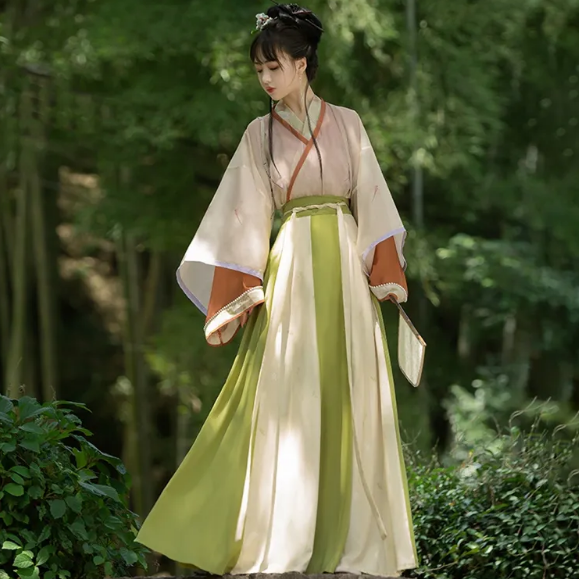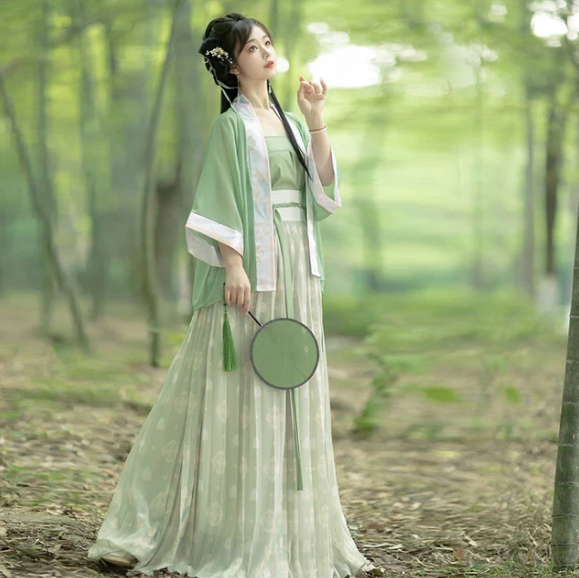Hanfu grooming standards involved specific clothing styles, symbolic colors, intricate accessories, and hairstyles denoting social status and cultural values.
Fundamentals of Hanfu Grooming Standards
The grooming standards associated with Hanfu offer a fascinating insight into the rich cultural and historical tapestry of ancient China. Hanfu, more than just traditional clothing, represents a deep-seated cultural identity and aesthetic preference deeply rooted in the Chinese ethos. This traditional attire, characterized by its flowing lines and graceful forms, serves as a living canvas displaying the artistic sensibility and social values of ancient Chinese society. The elegance of Hanfu lies in its simplicity and the profound symbolism embedded in every fold and hue.
Clothing Styles and Materials
The styles of Hanfu vary significantly, mirroring the cultural and political shifts across various Chinese dynasties. In the Tang dynasty, for example, clothing styles favored loose and flowing robes, often crafted from silk, a material celebrated for its luxurious texture and shimmering appearance. Silk in Hanfu isn’t merely a choice of fabric; it is a cultural symbol, representing China’s advanced skills in sericulture and textile production. These garments often feature intricate embroidery, incorporating designs like dragons and phoenixes, each a symbol of different virtues and social statuses. The choice of fabric, along with the garment’s cut and drape, reflects not only the fashion preferences of the period but also the wearer’s social standing and philosophical beliefs.

Cultural Significance of Colors and Patterns
In Hanfu, colors are more than aesthetic elements; they carry deep symbolic meanings and are a direct reflection of the philosophical underpinnings of ancient Chinese society. Red, often used in wedding attire, symbolizes joy and good fortune, aligning with the celebratory nature of the occasion. Blue, representing tranquility and stability, is frequently seen in everyday Hanfu. These color choices, deeply influenced by Confucian, Taoist, and Buddhist thought, showcase a desire to maintain harmony between humanity and nature. Patterns in Hanfu also hold significant importance. The dragon motif, for instance, was exclusively used by the emperor and his close relatives, symbolizing supreme power and authority. Commoners often adorned their garments with peony patterns, a symbol of wealth and honor. Each color and pattern woven into Hanfu is a story in itself, reflecting the moral values, natural world, and cosmic principles revered in ancient China.
Each element of Hanfu, from the fabric to the colors and patterns, is a testament to China’s historical legacy. These grooming standards do more than dictate fashion; they offer a glimpse into the societal norms, beliefs, and artistic achievements of an ancient civilization. Hanfu stands as a symbol of China’s journey through the ages, embodying the essence of its rich cultural heritage and aesthetic values.
Hairstyles and Headwear
The hairstyles and headwear in ancient Han Chinese culture were not mere fashion choices but deeply symbolic and integral to social identity. They reflect the intricate social hierarchies and moral philosophies of the time. Hair, regarded as a vital gift from one’s parents, was treated with great respect, and the styling of it held significant cultural weight.
Typical Hairstyles in Ancient Han Chinese Culture
In ancient Han Chinese culture, hairstyles varied widely, often signifying age, marital status, and social rank. For men, the ‘jian’ hairstyle, which involved keeping the front hair short and growing the back long, was popular. After a coming-of-age ceremony, usually around the age of 20, men would tie their long hair into a bun, known as ‘shu.’ Women, on the other hand, sported a variety of hairstyles, often elaborated for special occasions like weddings. Young, unmarried women typically wore their hair down or in simple braids, while married women preferred intricate buns adorned with various accessories. The ‘ji’ hairstyle, a high-standing bun, was a favorite among noblewomen, symbolizing elegance and grace.
Varieties and Symbolism of Head Accessories
Head accessories in ancient Han Chinese culture were as varied and symbolic as the hairstyles themselves. Men and women of higher social standings often wore intricate headpieces that denoted their status. The ‘zhan chi,’ a type of crown with hanging beads, was commonly worn by emperors and signified supreme authority. Noblewomen often adorned their hair buns with ‘buyao,’ a swaying hairpin that moved as they walked, symbolizing refinement and femininity. Commoners, restricted by law from wearing extravagant headwear, often opted for simpler decorations like fabric hairbands or plain hairpins. These head accessories were not just decorative but also conveyed messages about the wearer’s identity and social standing.
Each hairstyle and headpiece in ancient Han Chinese culture was a deliberate choice, laden with cultural significance and symbolism. From the simple hairpins of commoners to the elaborate crowns of emperors, these elements were a visual language, speaking volumes about the individual’s place in the intricate tapestry of ancient Chinese society.
Makeup and Facial Adornments
In ancient Han Chinese culture, makeup and facial adornments played a pivotal role, transcending mere cosmetic purposes to embody deeper cultural and symbolic meanings. These practices, rich in tradition, not only enhanced physical beauty but also served as a reflection of social customs, status, and philosophical beliefs.
Styles and Materials of Ancient Makeup
Throughout various Chinese dynasties, makeup styles evolved dramatically. Initially favoring natural looks in the Shang and Zhou dynasties, people gradually embraced more elaborate makeup in later periods, like the Tang and Song dynasties. Women often used ‘doufen,’ a white powder made from finely milled rice, to achieve a highly valued pale and luminous complexion. They also applied rouge derived from safflower petals for a vibrant touch on cheeks and lips, symbolizing youth and vitality. Elegantly shaped eyebrows, often likened to willow leaves, were a staple of beauty. Men, while applying makeup more subtly, emphasized grooming and refinement as a sign of dignity.
Cultural Background of Facial Applications
Facial applications in ancient China carried profound cultural and philosophical significance. For example, during the Han dynasty, court ladies adorned their foreheads with ‘yue se,’ crescent moon-shaped decorations symbolizing lunar deities and believed to bring protection and fortune. Women also adorned their faces with small plum blossom stickers, a tribute to nature, symbolizing resilience and perseverance. These adornments were not merely decorative but were expressions of the wearer’s personal beliefs and connections to the natural and spiritual realms.
In this context, makeup and facial adornments in ancient Chinese culture were far more than aesthetic choices; they were an intricate language of beauty, intertwined with the cultural fabric and philosophical underpinnings of the society. They offered insights into an individual’s social standing, personal beliefs, and aesthetic preferences.

Etiquette and Social Status
In ancient Han Chinese culture, etiquette and social status played a crucial role in shaping societal interactions and norms. Dressing was not just a matter of personal style but a reflection of one’s social standing, and adherence to etiquette was paramount. The intricate relationship between attire and social hierarchy was evident in every aspect of traditional Chinese life, from everyday activities to ceremonial occasions.
Dressing Norms for Different Occasions
The norms for dressing in ancient China varied greatly depending on the occasion, reflecting the importance of context in social interactions. During ceremonial occasions like weddings, festivals, and imperial court gatherings, people wore their most elaborate Hanfu, often adorned with intricate embroidery and symbols denoting good luck and prosperity. In contrast, everyday attire was simpler, prioritizing functionality and comfort, yet still conforming to social norms. For instance, scholars often wore long robes with wide sleeves, facilitating ease of movement and reflecting their intellectual status. Farmers and laborers wore more durable and practical clothing, suitable for physical work. Each choice of attire for different occasions was a deliberate expression of respect, status, and role within the society.
The Relationship Between Attire and Social Hierarchy
The relationship between attire and social hierarchy in ancient Han Chinese society was profound. Strict dress codes, often enforced by law, distinguished the nobility from commoners. Emperors and high-ranking officials wore robes with dragon motifs, symbolizing supreme power and authority. Nobles and scholars had their specific styles, often featuring finer fabrics and more intricate designs than those of the common people. Commoners were restricted in their use of colors and materials, often wearing simpler, undecorated garments. This clear demarcation in attire served as a visual representation of the social hierarchy, reinforcing the structured order of ancient Chinese society.
In ancient China, etiquette and social status were intricately linked to the way people dressed. Clothing was a powerful tool in communicating one’s social position, with every garment, color, and pattern carrying a specific meaning. This complex system of dressing norms and the relationship between attire and social hierarchy were integral parts of the cultural fabric, reflecting the values and structure of Han Chinese society.







